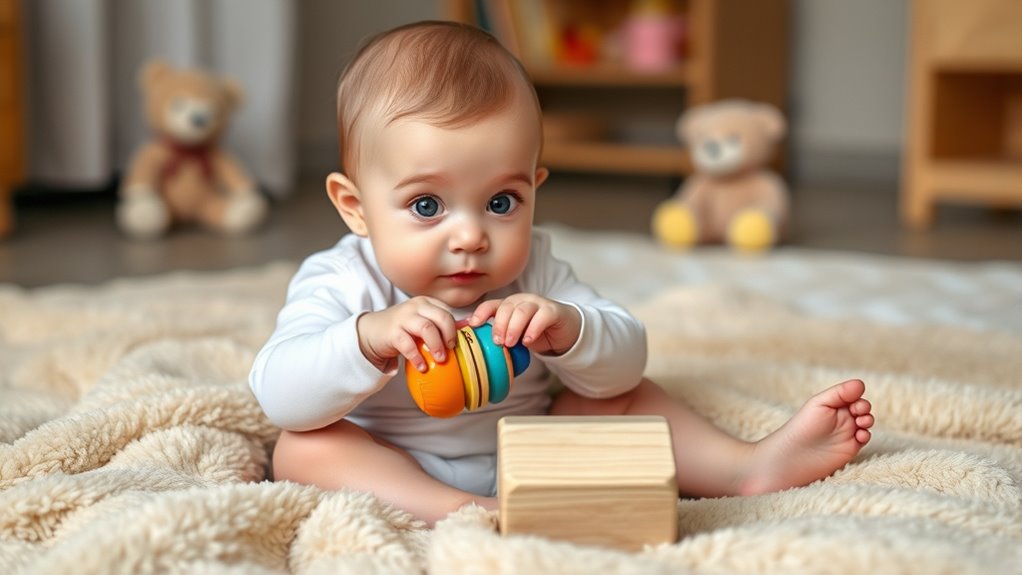Between 7 and 9 months, your baby makes great strides in sitting independently and gaining better control over their movements. They start to understand object permanence, recognizing that hidden objects still exist, which leads to interest in peekaboo and searching games. You can support this growth by providing safe spaces to explore and using toys that encourage reaching and discovering. Keep an eye on these milestones, and you’ll discover even more ways to foster your baby’s development.
Key Takeaways
- Between 7-9 months, babies sit steadily without support, using their hands for balance and reaching for objects.
- They begin understanding object permanence, recognizing that hidden items still exist.
- Babies actively search for partially covered or dropped toys, demonstrating growing problem-solving skills.
- Engaging in hide-and-seek games and covering objects helps reinforce their understanding of object permanence.
- Safe exploration and interactive play promote both motor control and cognitive development during this stage.

As your baby reaches 7 to 9 months, you’ll notice exciting developments in their sitting skills and understanding of object permanence. During this stage, your little one is rapidly advancing in motor development, which directly influences their ability to sit independently and explore their environment. You may see them sitting steadily without support, using their hands for balance, or even pivoting to reach new objects. These motor milestones are essential because they give your baby greater control over their movements, enabling them to engage more actively with their surroundings. As your baby refines their sitting skills, they’re also strengthening the muscles needed for crawling, standing, and eventually walking, marking a significant leap in their physical independence.
At the same time, your baby’s cognitive milestones become more pronounced. Their understanding of object permanence—knowing that objects continue to exist even when out of sight—begins to develop strongly at this age. You might notice that they become more interested in hiding games, like peekaboo, or look for toys that are partially covered or dropped behind furniture. This shows they’re starting to grasp that objects still exist even when you can’t see them, a crucial step in their cognitive development. Their curiosity grows, and they begin to search more deliberately for hidden items, which indicates their mental processes are becoming more sophisticated. This understanding not only boosts their problem-solving skills but also lays the foundation for more complex cognitive tasks later on.
Babies develop object permanence, understanding that objects exist even when out of sight, through games like peekaboo and exploring hidden items.
During this period, you should encourage your baby’s motor development by providing safe opportunities to sit and move freely. Use toys that motivate reaching, grasping, and exploring while they’re sitting. This physical activity fosters muscle strength and coordination. Simultaneously, engaging in simple games like hide-and-seek with toys or covering and uncovering objects can boost their developing understanding of object permanence. These activities are vital because they challenge your baby to use both their motor skills and cognitive understanding, creating a rich environment for growth. Additionally, research shows that interactive play significantly enhances cognitive and motor skills during this stage.
Remember that every baby develops at their own pace, so patience is key. Some might sit independently earlier or later, and their grasp of object permanence may vary. The combination of motor development and cognitive milestones at this stage is a dynamic process that unfolds uniquely for each child. By providing safe, engaging opportunities and plenty of encouragement, you’re supporting their growth in these exciting areas, setting a strong foundation for their ongoing development.
Frequently Asked Questions
How Does Sitting Development Vary Between Individual Babies?
You’ll notice that sitting development varies among babies, with some achieving posture improvement earlier due to stronger core muscles. As they sit, your baby engages in sensory exploration, which helps strengthen their muscles and coordination. While some may sit independently by a certain age, others might take a bit longer. Supporting their activities encourages confidence, and their unique pace reflects individual growth, making each milestone a special achievement.
When Should Parents Start Introducing Toys to Foster Object Permanence?
You can start introducing toys to foster object permanence around 4 to 6 months. Encourage toy exploration and sensory play by hiding toys partially or fully, so your baby begins to understand objects still exist even when out of sight. Use simple, safe toys that encourage reaching and grasping, helping develop their understanding of permanence. Keep play sessions engaging and responsive to your baby’s curiosity and developmental cues.
Are There Signs of Delayed Sitting or Object Permanence Development?
If your baby isn’t reaching developmental milestones like sitting unsupported or showing signs of object permanence, it might seem like they’re missing a huge part of childhood’s magic. You’ll notice delayed sitting when they can’t balance or push up, and delayed object permanence when they don’t search for hidden objects. Keep in mind, every baby explores through sensory exploration, but if concerns persist, consult a pediatrician for guidance and support.
How Can Caregivers Encourage Sitting Without Causing Frustration?
You can encourage sitting by providing plenty of positive reinforcement and using patience techniques. Offer your baby lots of praise and gentle encouragement whenever they try to sit, even if they wobble. Create a safe, supportive environment with soft cushions or pillows nearby. Remember to stay patient, celebrating small progress to avoid frustration. Your calm, encouraging approach helps build confidence and makes sitting a fun, rewarding milestone for your little one.
What Activities Best Support Cognitive Growth at This Stage?
You can support cognitive growth by engaging your baby in sensory play and social interaction. Offer textured toys, water, or sand to stimulate their senses and encourage exploration. Talk, sing, and play peekaboo to boost social skills and understanding of object permanence. These activities promote mental development, help your baby learn cause and effect, and strengthen your bond, making learning fun and effective at this stage.
Conclusion
At 7–9 months, you witness your baby sitting steadily and discovering object permanence. You see their curiosity grow, their confidence build, and their world expand. You feel pride as they explore, joy as they learn, and awe as they develop. You realize this is just the beginning, the foundation for future growth. Embrace these moments, cherish these milestones, and remember—each step forward is a step toward their bright, unfolding future.










